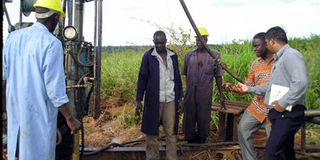Karuma hydro power project raises capacity

A geologist Iqrar Ahmed shows a drilling operation to Energy Commissioner Eng. James Baanabe (2nd R) during inspection of the survey activities at Karuma in Kiryandongo District.
Arrangements are underway to complete feasibility studies that include among others social and environment studies for the Karuma hydro power project.
This will pave way for the compensation and relocation of the affected persons and hiring a contractor to start construction sometime next year, officials say.
Energy officials add that the project, which was initially expected to generate 200MW under private financing will be constructed with funding from government to produce up to 600MW.
Karuma Hydropower project is one of the flagship projects in the national development plan funded by government after Norpak Power withdrew from the original construction of a 200MW plant.
According to the arrangement, the revised designs are looking at developing a bigger project with a higher capacity of about 600 MW harnessing 9 km of the river (Nile) stretch and a higher head of 70 metres.
James Baanabe explains that the government’s need to increase the capacity of the project was a result of the country’s increasing demand.
Set to offer employment opportunities to the local people in Kiryandongo and Apac districts, the project will see hundreds of people from five villages compensated under the Resettlement Action programme.
Baanabe, the Acting Commissioner Energy Resources Department during a sensitization workshop of the affected persons held in Karuma said the consultant on the project is currently conducting surveys to establish the people to be affected and the level of compensation needed.
He said this is a key project in the ministerial generation plans to increase hydro power generation and extend electricity coverage to other parts of the country for better livelihoods and the social and economic transformation of our nation.
“Our target is to ensure that the project is implemented within the time frame of the National Development Plan. Government intends to fast track the development of Karuma hydropower project as a public project to provide adequate generation capacity so as to provide adequate power supply. This project is being implemented together with the Karuma to Kawanda (approximately 250 km) which will be one of the lines for evacuation of electric power,” says Baanabe.
A project document indicates that the Uganda Electricity Transmission Company Ltd has a Grid Development Plan that is used in assessing the development of hydropower sites, developing new transmission lines, up-grading transmission lines and substations.
“…this Grid Development Plan also covers transmission lines related to (the) Karuma Hydro Power Project. The proposed lines are an integral part of Karuma Hydropower Project.
These lines will evacuate the generated power at Karuma to major load centres in Kampala, Lira and West Nile,” reads the document.
The document however says that Government will have to look for the required funds although at the moment it was premature to say how these transmission lines, combined with the Karuma Interconnection Project, will be financed.
They say that government would procure the contractor early 2011 while actual construction works are expected to start mid next year.
Baanabe says that at the moment the ministry has asked firms to apply for pre-qualification to be considered on the list of firms which will later be asked to apply as contractors to build the power station.
A total of twenty eight construction firms have tendered in their bids to be considered for shortlisting to construct the 600MW Karuma Hydropower plant in Kiryandongo District, says the energy official.
“A shortlist of experienced firms will be made to be issued bidding documents,” he said during a meeting with project affected people.
These changes necessitated new feasibility studies, including the technical designs, environmental impact assessment and resettlement action plan.
“This phase will be completed by February 2011 comprising of designs, EIA report and a detailed Resettlement Action Plan,” he says.
In November last year, government contracted Energy Infratech Pvt Ltd to carryout studies and come up with various options for optimizing the capacity of the site and carryout a detailed feasibility study and engineering design.
According to Baanabe, the company will by the end of this year have completed designs and the Environmental Social Impact (ESIA) report that will be reviewed by Nema as well as the Resettlement Action Project (RAP).




